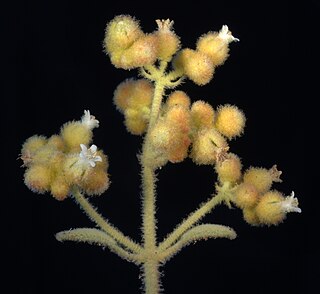
Lachnostachys is a genus of flowering plants in the mint family, Lamiaceae, first described in 1842 by William Jackson Hooker. The type species is Lachnostachys ferruginea. The genus name, Lachnostachys, comes from two Greek words/roots, lachnề ("wool") and -stachys, and thus describes the genus as having spiked woolly inflorescences. The entire genus is endemic to Western Australia

Newcastelia is a genus of flowering plants in the mint family, Lamiaceae, first described in 1857 by Ferdinand von Mueller, who placed it in the family, Verbenaceae. The entire genus is endemic to Australia.
- Newcastelia bracteosaF.Muell. - Western Australia, South Australia, Northern Territory
- Newcastelia cephalanthaF.Muell. - Western Australia, South Australia, Northern Territory, Queensland
- Newcastelia cladotrichaF.Muell. - Western Australia, Northern Territory
- Newcastelia ellipticaMunir - Western Australia, Northern Territory
- Newcastelia hexarrhenaF.Muell. - Western Australia
- Newcastelia insignisE.Pritz. - Western Australia
- Newcastelia interruptaMunir - Queensland
- Newcastelia roseoazureaRye - Western Australia
- Newcastelia spodiotrichaF.Muell. - Western Australia, South Australia, Northern Territory
- Newcastelia velutinaMunir - Queensland

Prostanthera prostantheroides is a plant in the family Lamiaceae and is endemic to Western Australia. It is a shrub with heart-shaped to round leaves and usually white flowers with purple spots inside the petal tube.

Grevillea commutata is a species of flowering plant in the family Proteaceae and is endemic to the west of Western Australia. It is a spreading, open to dense shrub with egg-shaped leaves with the narrower end towards the base, and white, cream-coloured, and pinkish-green flowers.

Quoya dilatata is a flowering plant in the mint family Lamiaceae and is endemic to Western Australia. It is a low, spreading shrub with its branches and leaves densely covered with a layer of white, woolly hairs. The leaves are wrinkled or crinkly and the tube-shaped flowers are orange-red and hairy on the outside.

Pityrodia hemigenioides is a flowering plant in the mint family Lamiaceae and is endemic to the south-west of Western Australia. It is a spreading shrub with densely hairy branches and leaves, and pale white flowers near the ends of the branches.

Quoya verbascina, commonly known as golden bush, is a flowering plant in the mint family Lamiaceae and is endemic to Western Australia. It is an erect shrub with its branches and leaves densely covered with woolly hairs. The leaves are often oblong but very variable in shape and the flowers are pinkish-white with pink spots inside and are surrounded by yellow woolly sepals.

Parsonsia diaphanophleba is a woody vine of the family Apocynaceae. It is found in Western Australia and is listed as a priority 4 species.

Dicrastylis exsuccosa is a species of plant within the genus, Dicrastylis, in the family Lamiaceae. It is endemic to inland Australia and found in Western Australia, the Northern Territory and South Australia.

Newcastelia cephalantha is a species of plant belonging to the mint family, Lamiaceae, and native to several Australian states: Queensland, South Australia, Western Australia and the Northern Territory

Leucopogon plumuliflorus is a species of flowering plant in the heath family Ericaceae and is endemic to the south-west of Western Australia. It is a weakly erect shrub with egg-shaped leaves and spikes of white or pinkish-white, tube-shaped flowers.

Prostanthera canaliculata is a species of flowering plant in the family Lamiaceae and is endemic to the south-west of Western Australia. It is a small, erect shrub with hairy branchlets, narrow egg-shaped to narrow elliptical leaves and pale blue or pale violet to white flowers with no markings.

Dicrastylis beveridgei is a species of plant within the genus, Dicrastylis, in the family Lamiaceae. It is found in Western Australia, the Northern Territory, and South Australia.

Dicrastylis doranii is a species of plant within the genus, Dicrastylis, in the family Lamiaceae. It is found in Western Australia, the Northern Territory, and South Australia.

Dicrastylis lewellinii is a species of plant within the genus, Dicrastylis, in the family Lamiaceae. It is found in Western Australia, the Northern Territory, New South Wales, Queensland and South Australia.

Westringia cephalantha is a shrub in the Lamiaceae family that is endemic to Western Australia.

Teucrium teucriiflorum is a species of flowering plant in the family Lamiaceae, and is endemic to arid and semi-arid areas of Australia. It is a semi-scandent shrub with many branches, linear to narrow lance-shaped or narrow egg-shaped leaves and creamy-white flowers.

Lachnostachys eriobotrya is a plant in the Lamiaceae family, native to Western Australia.

Newcastelia roseoazurea is a species of plant belonging to the mint family, Lamiaceae, and native to Western Australia.

Hemigenia teretiuscula is a species of flowering plant in the family Lamiaceae and is endemic to the southwest of Western Australia. It is an upright, glabrous shrub that typically grows to a height of 10–80 cm (3.9–31.5 in), the leaves about 1 mm (0.039 in) in diameter, more or less tapering cylindrical and somewhat sharply pointed. Flowering usually occurs from August to December and the flowers are bluish-purple.


























